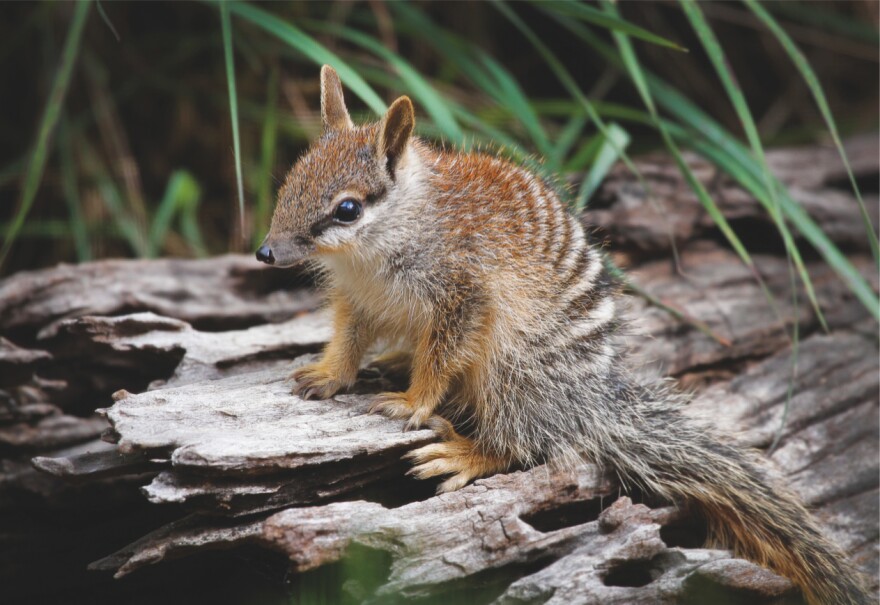To make the New Numbat Artificial Diet, mix together powdered cat chow, hen's eggs and water. Cook on low heat for 10 minutes and cool. Add calcium carbonate, a vitamin-mineral supplement, cellulose powder, fish oil, Vitamin B12 and crushed termite mound.
"It looks weird, it smells strange, but they love it," says Peter Mawson, director of animal health and research at the Perth Zoo in Australia. Mawson would know. His team has spent more than a decade perfecting the recipe for these squirrel-sized, termite-eating marsupials.
All around the world, feeding animals in captivity takes a particular kind of chef, and budget. Each year, for instance, animals at the St. Louis Zoo in Missouri consume about 5 tons of carrots, 7.5 tons of bananas, 85 tons of herbivore pellets, 22,000 adult mice and 1.6 million mealworms. And instead of relying on outside suppliers for the 293 tons of hay it uses each year, the Smithsonian National Zoo, in Washington, D.C., has taken to growing its own.

Feeding can be tricky, since zoo animals have rather unusual dietary needs. Birds like the flamingo and the scarlet ibis derive their brilliant pigmentation from the shrimp, krill and crustaceans in their diets. But they're expensive and tough for zoos to source. Cut them out and the birds' feathers fade.
"They're perfectly happy being white," Mawson says. But what zoo visitor wants to see a white flamingo, really? It's now common to maintain the rosy coloration by feeding the birds beta carotene supplements.
And consider the gorilla. The big apes in captivity have a nasty habit of eating high-starch foods, throwing them up, and then eating them again, says Marcus Clauss, a veterinarian with a specialization in animal nutrition at the University of Zurich in Switzerland. Part of the problem is that the domesticated fruit that is fed to zoo animals is way sweeter than anything the animals would find in the wild.
"If you have a good biologist in your zoo, and if he wants to teach reality to zoo visitors, he cannot allow a banana to be in the monkey enclosure," Clauss says. "[The monkey eating a banana in the wild] is a literary myth." At the Zurich zoo, monkeys and apes no longer get bananas.
At least those modifications are relatively straightforward. If you had an animal like a vampire bat, says Mike Maslanka, a nutritional physiologist and chief of nutrition science at the Smithsonian zoo, you would need a ready supply of blood. (The Smithsonian does not house vampire bats.)
And if you wanted to feed numbats their native diet, you would need live termites — 15,000 to 20,000 of them per day, per animal. Perth Zoo currently has 40 numbats. That's a lot of termites.
Hence the solution: supplementing with kibble. Clauss says the first question he gets from most colleagues who know something about feeding zoo animals is: "Should you use dog kibble or cat kibble?" Nowadays, cat food forms the basis of most prepackaged diets given to captive carnivorous animals, including anteaters, like numbats.

Cat kibble, however, is just the starting point. Clauss likes to ask his students to describe the natural diet of the anteater. "Students will say, 'It's ants and termites.' Well, that's 50 percent of the truth," Clauss says. "Imagine there's an anthill and you lick it with your tongue. Half of that is just dirt."
The staff at the Perth Zoo started trying to breed numbats in 1993. By then the numbat — the mammal emblem of the state of Western Australia — was critically endangered, with an estimated 500 adults left in the wild. Thanks, in part, to the zoo's efforts, the numbat population is now thought to be around 1,000.
Initially , Mawson fed the zoo numbats modified cat chow with crushed termite — along with some live termites. He included the live insects in hopes that the zoo-reared animals will remember the flavor when released to forage on their own in the open eucalyptus forests and woodland of Western Australia.
But the captive females failed to produce enough milk on that diet and their babies died.
So Mawson began tweaking his recipe. It was slow going. Female numbats gestate for 30 days and then nurse for another 11 months or so. That meant Mawson could only make one dietary change per year. One year, he tried upping the protein and lipid content of the slurry by mixing in crickets and mealworms. But, with temperatures reaching up to 111 degrees Fahrenheit in Perth, within hours the mix oxidized and developed a dark crust. The numbats refused to eat it. Mawson scrapped the crickets and mealworms and just added more powdered chow.
Then, somewhere along the way, Mawson's numbats got the runs. The keepers had to continually clean the animals' feet and fur — a huge stressor for all involved. Something had to change.
Mawson reasoned that because numbats eat termites, they must also eat all those tree fibers in the termites' guts. So he added cellulose powder. The diarrhea stopped.
Just this year, the Perth zoo's numbats produced a record 25 young. Mawson was ecstatic. But not everyone's happy. One numbat regularly combs his servings of New Numbat Artificial diet for the bits of crushed termite mound, and refuses to eat the rest of the slurry. There's always the one, Mawson laments, that behaves "like a 2-year-old."
Sujata Gupta is a freelance science writer based in Burlington, Vermont. Her work has appeared online and in print in the New Yorker, BBC, NovaNext, Scientific American and others. Follow her on Twitter @sujatagupta.
Copyright 2021 NPR. To see more, visit https://www.npr.org.

